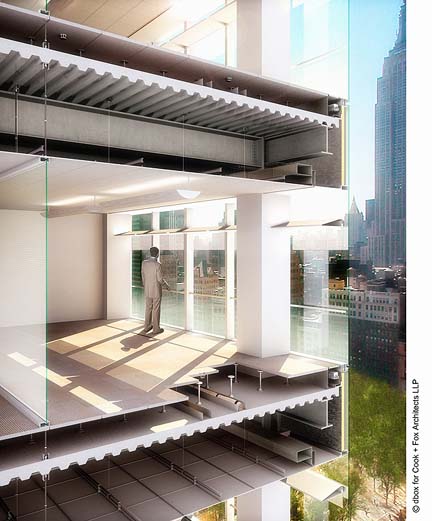 One Bryant Park: The Bank of America Tower. The most ambitious eco-friendly skyscraper. Cook+ Fox Architects
One Bryant Park: The Bank of America Tower. The most ambitious eco-friendly skyscraper. Cook+ Fox Architects Set to rise 54 stories above Manhattan, the crystalline Bank of America Tower at One Bryant Park will incorporate an unrivaled number of environmentally friendly technologies, from its windows to its toilets. The building will supply 70 percent of its own energy with an on-site natural-gas-burning power plant. For climate control, One Bryant Park will rely on excess thermal energy from the power plant, a groundwater heat exchanger that is the first of its type, and an air-conditioning system cooled by ice made with excess power during off-peak hours. The building will even have waterless urinals and use water collected from the roof to flush toilets. Together, these systems are designed to earn the building a Platinum rating-the highest possible-from the U.S. Green Building Council when construction is completed in 2008 and, the builders hope, will also save the kind of green that ma
 tters to shareholders.
tters to shareholders."Green" Considerations
With an emphasis on sustainability, water efficiency, indoor environmental quality, and energy and atmosphere, the Bank of America Tower will be constructed largely of recycled and recyclable building materials. It will feature a wide range of sophisticated environmental technologies, from filtered under-floor displacement air ventilation to advanced double-wall technology and translucent insulating glass in floor-to-ceiling windows that permit maximum daylight and optimum views. It also will include a state-of-the-art onsite 4.6-megawatt cogeneration plant, providing a clean, efficient power source for the building's energy requirements.
The Bank of America Tower will save millions of gallons of water annually through such innovative devices such as a gray-water system to capture and reuse all rain and wastewater, while planted roofs will reduce the urban heat island effect. Taking advantage of heat energy from the cogeneration plant, a thermal storage system will produce ice in the evenings, which will reduce the building's peak demand loads on the city's electrical grid. Daylight dimming and LED lights will reduce electric usage while carbon dioxide monitors automatically introduce more fresh air when necessary. By fundamentally changing the way buildings are conceived, Bank of America Tower will lead the change in the way high-rise buildings are built.
Environmental advantages
Building site of Bank of America Tower, seen from Bryant ParkThe design of the building will make it environmentally friendly, using technologies such as floor-to-ceiling insulating glass to contain heat and maximize natural light, and an automatic daylight dimming system. The tower also features a greywater system, which captures rainwater and reuses it. Bank of America also states that the building will be made largely of recycled and recyclable materials.[5] Another innovation is that not only is air entering the building purified to a high degree, but the air exhausted is also cleaner, thus effectively making the tower a giant air filter for Midtown Manhattan.[6] Bank of America Tower is the first skyscraper designed to attain a Platinum LEED Certification.[5]
Features
The Bank of America tower is constructed using a concrete manufactured with slag, a byproduct of blast furnaces. The mixture used in the tower concrete is 55% cement and 45% slag. The use of slag cement reduces damage to the environment by decreasing the amount of cement needed for the building, which in turn lowers the amount of carbon dioxide greenhouse gas produced through normal cement manufacturing. (One ton of cement produced emits about one ton of carbon dioxide into the atmosphere.)
Control of the temperature of Bank of America's tower, and the production of some of its energy, will be done in an environmentally-friendly manner. Insulating glass will reduce thermal loss somewhat, which will lower energy consumption and increase transparency. Carbon dioxide sensors will signal increased fresh air ventilation, when elevated levels of carbon dioxide are detected in the building.
The cooling system will produce and store ice during off-peak hours, and then use ice phase transition to help cool the building during peak load, similar to the ice batteries in the 1995 Hotel New Otani in Tokyo Japan.[3] Ice batteries have been used since absorption chillers first made ice commercially 150 years ago, before the electric light bulb was invented.[4] New green building architects are just now rediscovering the old cost-effective ice battery technique.
The tower has a 4.6-megawatt cogeneration plant, which will provide part of the base-load energy requirements. Onsite power generation reduces the significant electrical transmission losses that are typical of central power production plants.
No hay comentarios:
Publicar un comentario